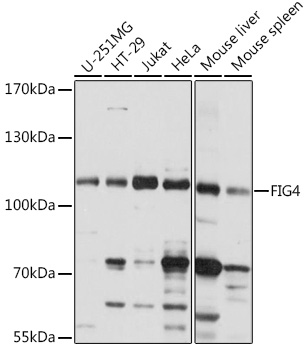Anti-FIG4 Antibody (CAB15372)
- SKU:
- CAB15372
- Product type:
- Antibody
- Reactivity:
- Human
- Mouse
- Host Species:
- Rabbit
- Isotype:
- IgG
- Antibody Type:
- Polyclonal Antibody
- Research Area:
- Cell Biology
Frequently bought together:
Description
| Antibody Name: | Anti-FIG4 Antibody |
| Antibody SKU: | CAB15372 |
| Antibody Size: | 20uL, 50uL, 100uL |
| Application: | WB |
| Reactivity: | Human, Mouse |
| Host Species: | Rabbit |
| Immunogen: | Recombinant fusion protein containing a sequence corresponding to amino acids 608-907 of human FIG4 (NP_055660.1). |
| Application: | WB |
| Recommended Dilution: | WB 1:200 - 1:2000 |
| Reactivity: | Human, Mouse |
| Positive Samples: | U-251MG, HT-29, Jukat, HeLa, Mouse liver, Mouse spleen |
| Immunogen: | Recombinant fusion protein containing a sequence corresponding to amino acids 608-907 of human FIG4 (NP_055660.1). |
| Purification Method: | Affinity purification |
| Storage Buffer: | Store at -20°C. Avoid freeze / thaw cycles. Buffer: PBS with 0.02% sodium azide, 50% glycerol, pH7.3. |
| Isotype: | IgG |
| Sequence: | WELP TDFY LHHK NTMR LLPT RRSY TYWW TPEV IKHL PLPY DEVI CAVN LKKL IVKK FHKY EEEI DIHN EFFR PYEL SSFD DTFC LAMT SSAR DFMP KTVG IDPS PFTV RKPD ETGK SVLG NKSN REEA VLQR KTAA SAPP PPSE EAVS SSSE DDSG TDRE EEGS VSQR STPV KMTD AGDS AKVT ENVV QPMK ELYG INLS DGLS EEDF SIYS RFVQ LGQS QHKQ DKNS QQPC SRCS DGVI KLTP ISAF SQDN IYEV QPPR VDRK STEI FQAH IQAS QGIM QPLG KEDS SMYR EYIR NRYL |
| Gene ID: | 9896 |
| Uniprot: | Q92562 |
| Cellular Location: | Endosome membrane |
| Calculated MW: | 103kDa |
| Observed MW: | 104kDa |
| Synonyms: | FIG4, ALS11, BTOP, CMT4J, KIAA0274, SAC3, YVS, dJ249I4.1 |
| Background: | The protein encoded by this gene belongs to the SAC domain-containing protein gene family. The SAC domain, approximately 400 amino acids in length and consisting of seven conserved motifs, has been shown to possess phosphoinositide phosphatase activity. The yeast homolog, Sac1p, is involved in the regulation of various phosphoinositides, and affects diverse cellular functions such as actin cytoskeleton organization, Golgi function, and maintenance of vacuole morphology. Membrane-bound phosphoinositides function as signaling molecules and play a key role in vesicle trafficking in eukaryotic cells. Mutations in this gene have been associated with Charcot-Marie-Tooth disease, type 4J. |
| UniProt Protein Function: | SAC3: The PI(3,5)P2 regulatory complex regulates both the synthesis and turnover of phosphatidylinositol 3,5-bisphosphate (PtdIns(3,5)P2). In vitro, hydrolyzes all three D5-phosphorylated polyphosphoinositide substrates in the order PtdIns(4,5)P2 > PtdIns(3,5)P2 > PtdIns(3,4,5)P3. Plays a role in the biogenesis of endosome carrier vesicles (ECV) / multivesicular bodies (MVB) transport intermediates from early endosomes. Defects in FIG4 are the cause of Charcot-Marie-Tooth disease type 4J (CMT4J). CMT4J is a recessive demyelinating, severe form of Charcot-Marie-Tooth disease, the most common inherited disorder of the peripheral nervous system. Charcot-Marie-Tooth disease is classified in two main groups on the basis of electrophysiologic properties and histopathology: primary peripheral demyelinating neuropathies characterized by severely reduced motor nerve conduction velocities (NCVs) (less than 38m/s) and segmental demyelination and remyelination, and primary peripheral axonal neuropathies characterized by normal or mildly reduced NCVs and chronic axonal degeneration and regeneration on nerve biopsy. Defects in FIG4 are the cause of amyotrophic lateral sclerosis type 11 (ALS11). ALS is a neurodegenerative disorder affecting upper motor neurons in the brain and lower motor neurons in the brain stem and spinal cord, resulting in fatal paralysis. Sensory abnormalities are absent. Death usually occurs within 2 to 5 years. The etiology of amyotrophic lateral sclerosis is likely to be multifactorial, involving both genetic and environmental factors. The disease is inherited in 5-10%. |
| UniProt Protein Details: | Protein type:EC 3.1.3.- Chromosomal Location of Human Ortholog: 6q21 Cellular Component: early endosome membrane; endosome membrane; Golgi membrane; late endosome membrane Molecular Function:phosphatidylinositol-3,5-bisphosphate 5-phosphatase activity; protein binding Biological Process: phosphatidylinositol biosynthetic process Disease: Amyotrophic Lateral Sclerosis 11; Charcot-marie-tooth Disease, Type 4j; Polymicrogyria, Bilateral Temporooccipital; Yunis-varon Syndrome |
| NCBI Summary: | The protein encoded by this gene belongs to the SAC domain-containing protein gene family. The SAC domain, approximately 400 amino acids in length and consisting of seven conserved motifs, has been shown to possess phosphoinositide phosphatase activity. The yeast homolog, Sac1p, is involved in the regulation of various phosphoinositides, and affects diverse cellular functions such as actin cytoskeleton organization, Golgi function, and maintenance of vacuole morphology. Membrane-bound phosphoinositides function as signaling molecules and play a key role in vesicle trafficking in eukaryotic cells. Mutations in this gene have been associated with Charcot-Marie-Tooth disease, type 4J. [provided by RefSeq, Jul 2008] |
| UniProt Code: | Q92562 |
| NCBI GenInfo Identifier: | 2497367 |
| NCBI Gene ID: | 9896 |
| NCBI Accession: | Q92562.1 |
| UniProt Secondary Accession: | Q92562,Q53H49, Q5TCS6, |
| UniProt Related Accession: | Q92562 |
| Molecular Weight: | 103,635 Da |
| NCBI Full Name: | Polyphosphoinositide phosphatase |
| NCBI Synonym Full Names: | FIG4 phosphoinositide 5-phosphatase |
| NCBI Official Symbol: | FIG4 |
| NCBI Official Synonym Symbols: | YVS; BTOP; SAC3; ALS11; CMT4J; KIAA0274; dJ249I4.1 |
| NCBI Protein Information: | polyphosphoinositide phosphatase |
| UniProt Protein Name: | Polyphosphoinositide phosphatase |
| UniProt Synonym Protein Names: | Phosphatidylinositol 3,5-bisphosphate 5-phosphatase; SAC domain-containing protein 3 |
| Protein Family: | Polyphosphoinositide phosphatase |
| UniProt Gene Name: | FIG4 |
| UniProt Entry Name: | FIG4_HUMAN |






